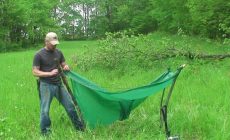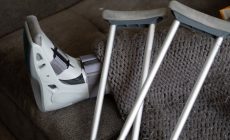Survival in the wilderness can test even the most self-proclaimed fearless, and confident people. Facing unknown circumstances and coming across unprecedented challenges can have you thinking about all sorts of things that can help you endure persistent conditions of the untamed boondocks surrounding you.
In such a case, every veteran camper would relay the importance of makeshift tools that can exponentially increase your chances of continued existence. However, crafting them can definitely take time and effort backed by the willpower of never to give up.
According to a recent study by Survival Dispatch, people die from being lost in the woods every day in the United States. In fact, Yosemite National Forest Search and Rescue’s research showed that 4,661 people per year were lost in the woods and required assistance.
This comes to around 13 people per day, whereas the nationwide estimate is around 50,000 search and rescue missions conducted each year. Moreover, 48% of hikers and 21% of boaters are people with the highest rate of getting lost.
In light of this information, let’s take a quick look at some of the ways you can craft sharp stone tools to ensure your survival until helps reaches you.
· Choosing the Right Rocks

It is important that you understand the picking the right rocks for making stone tools such as a survival knife can help you accomplish the right results and in much less time.
Eventually, everything breaks over time; however, it makes a ton of difference that you know which rocks to choose for making your stone tools. The following rocks can all be broken down to make sharp cutting tools that can aid you in your survival against the wild:
- Chalcedony – a cryptocrystalline form of silica. It is composed of very intergrowths of quartz a moganite. It is a semiprecious stone that you can find near rivers, lakes, and other water bodies.
- Chert – it is a dark, hard, and opaque rock composed of silica with an amorphous or microscopically fine-grained texture. Thick beds of chert occur in marine deposits.
- Flint – a hard gray rock that consists of nearly pure chert and can occur as nodules in chalk. Since ancient times, a flint that has been flaked or grounded was used to form a tool or weapons.
- Jasper – usually in brown, green, red, or yellow and rarely blue, Jasper is an aggregate of micro-granular quartz or chalcedony. Jasper is opaque, and it is fairly common, available in many places.
- Obsidian – a naturally occurring volcanic glass that is formed of ingenious rocks. This rock comes into existence when felsic lava from a volcano cools rapidly with minimal crystal growth.
- Quartz – composed of silicon and oxygen atoms, quartz is a hard crystalline mineral that is the most abundant mineral found at Earth’s surface. It is the fourth strongest material after diamond, sapphire, and topaz.
· Flintknapping

Once you have selected the rocks, you would next be required to shape them. This is where knapping comes in, which is a method of shaping through a process called ‘lithic reduction”.
Lithic reduction is a process where stones and rocks are fashioned into tools from their natural state by removing some parts. Through this process, you can produce flat-faced stone for buildings and even flush-work decoration. Here are three types of techniques that you can use:
- Bi-Polar Percussion – here, you carefully strike the hammer rock directly on top of your source rock while it is placed on an anvil stone. The anvil stone is the largest rocks out of the three with a preferably flat surface. The best way is to strike the rock while making it stand on its longest axis, which causes your blow to radiate at both ends of the rock and allows it to break easily.
- Percussion Flaking – here, you use the hammer rock to strike the source rock’s edge to break off flakes.
- Rock Bash Method – a rough technique where you collide one rock on top of another with enough force that can result in the edges or blades breaking off.
· The Source Rock

The source rock is from which you will make your tool. Two essential stone tools that you should aim for are a stone knife and a stone hammer. Both offer you an incredible range of utility and can immensely help you to survive the wild. A good source rock shape is a larger, straight slab with perpendicular edges, o it could be round and smooth.
· The Hammer Rock

The hammer rock has to be harder than the source rock. Hence it should not only be sturdier but also not be prone to flaking. On the other hand, you can also create a soft hammer that is made of antler, bone or wood.
The soft hammer is used for refining the edges of your stone tools. At University Assignment Help, young learners are encouraged to explore natural beauty but with proper supervision and under their guardians’ watchful eyes.
· Using Your Stone Tools

Once you have your stone tools ready, it is best that you look after them as well. For instance, if you end up making a stone axe, then using it at precisely 90-degrees can put the stone axe at the risk of breaking due to ‘side-slap’ force. Hence it is best that you use it to chop things at angles just shy of 90-degrees.
Also, ask others to stay away if you are using stone tools because you will often end up with debris flying around you, which can hurt others. Lastly, a slow and steady process for knapping produced better results than knapping quickly and repeatedly.
You can also use the leftover flakes to make blades and arrowheads. Pupils who buy essay online UK should consider using their stone tools in turns and replacing them with new ones when the old ones wear out.
· Some Precautions for Knapping

Before I end this post, I would like to bring forward some hazards associated with knapping itself. While out in the open, you would hardly have access to industrialized tools to carry out making tools out of stone. The primitive method of knapping does present some danger to your health. It is has been historically studied that flint knapping can commonly cause people to suffer from silicosis.
This is when a person who is making stone tools inhales flint dust unintentionally. This causes inflammation and scarring in the form of nodular lesions in the upper lobes of the lungs. In 2013 alone, around 43,000 deaths around the world were caused by silicosis.
Therefore it is extremely important that you wear a face mask or some sort of cloth covering to prevent the fine dust from the stone you are carving to enter your nostril.
It is best that you also wear eye-protection goggles or eyewear that can help prevent the fine dust cause irritation to your eyes as well. Additionally, this fine dust can also harm your hands’ skin as our skin is porous in nature, which can lead to further health-related troubles. Wearing protective gloves can help resolve the problem.
Conclusion
I hope this post was able to help you find the courage to face the wilderness alone. If you are ever in a position where your survival chances seem less opportune, then use the time on your hand to creating a stone axe.
Even though it may serve as a temporary solution, a sturdy and crudely crafted stone axe can at times mean the difference between life and death. Your stone tools should be good enough to help you survive until you are rescued or find your way back to civilization. All the best for your future endeavors!
Author Bio
Melissa Calvert currently works as a devoted SEO Expert at Crowd Writer and Master Thesis. This is where higher education students can acquire professional essay writing service from experts specializing in their field of study. During her free time, she likes to go camping and explore scenic beauty with friends and family.




















2 Comments
Eileen Valdez
July 24, 2021 - 1:40 pmIt is an amazing post and you explained in a detailed way. Nice to see this here. I will bookmark your blog for more details. Keep sharing the new things like this.
Erica Frank
July 15, 2022 - 2:23 pmYour style is very unique in comparison to other people I have read stuff from.
Many thanks for posting when you have the opportunity, Guess I will just bookmark this blog.